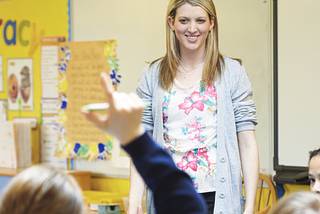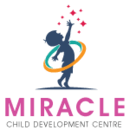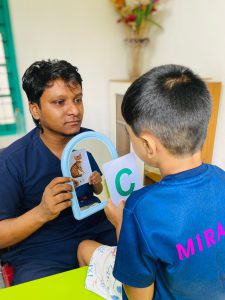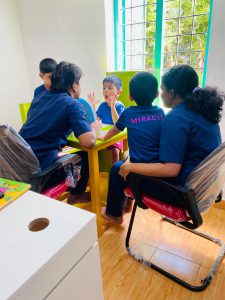Speech and Language Therapy
Our Approach to Speech and Language Therapy for Children
Our Strategy
Our speech and language therapists are highly trained specialists who have a thorough grasp of the special requirements of children with developmental disabilities. We use a holistic and tailored approach, realizing each child’s experience is unique. Our Speech and Language Therapy department offers various interventions, including:

Interventions
Speech Articulation Therapy: This intervention aims to improve a child’s ability to enunciate sounds and words correctly. It is beneficial to children who have speech sound abnormalities, articulation disorders, or phonological disorders.
Language Comprehension Therapy: This intervention tries to improve receptive language abilities in children who fail to understand spoken language. It offers tasks to help students enhance their vocabulary, comprehension, and ability to follow instructions.
Expressive Language Therapy: This intervention assists youngsters in becoming more effective communicators by enhancing their ability to express themselves verbally or nonverbally. It focuses on vocabulary development, sentence creation, and communication skills.
Social Communication Skills Development: Children with developmental disabilities frequently require specialized assistance in establishing social communication skills. This intervention focuses on the ability to start and maintain interactions, as well as interpret social signs.
Fluency Therapy: This intervention improves the flow of speech and reduces instances of disfluency in children who stutter or have other fluency issues.
Augmentative and Alternative Communication (AAC): Some children may benefit from augmentative and alternative communication (AAC) systems, which include communication gadgets, photo exchange systems, and sign language. Our therapists are educated in AAC therapies for children who are nonverbal or have limited verbal communication.
Feeding and Swallowing Therapy: Our therapists provide interventions to improve oral-motor skills, swallowing safety, and overall feeding ability for children who have feeding and swallowing challenges.
Parent and Caregiver Education: We understand the critical role that parents and caregivers play in their children’s language development. Our therapists collaborate closely with families to provide training and home-based techniques.
Positive Results
Speech and language therapists at the Miracle Earley Intervention Clinic and Child Development Centre play an important role in assisting children with speech and language difficulties.
How they can assist your child at our Centre:
1. Evaluation and Diagnosis: Speech and language therapists begin by completing thorough assessments to determine your child’s unique speech and language issues. This preliminary assessment serves as the foundation for creating a personalized treatment plan.
2. Customized Treatment Plans: Therapists develop individualized treatment programs based on the evaluation findings for your child’s specific needs and goals. These plans detail the exact interventions and tactics that will be put in place.
3. Improved Articulation: Therapists deal with children who have articulation difficulties to improve their ability to speak sounds and words appropriately. They assist your youngster articulate more clearly with specific workouts and activities.
4. Improvement of Phonological Skills: If your kid has phonological abnormalities, therapists will work with them to arrange and simplify speech sounds, resulting in more accurate and intelligible speaking.
5. Fluency Improvement: Children with fluency issues, such as stuttering, are given therapies to improve their fluency and decrease disfluencies in their speech. Therapists teach communication methods that promote smooth and fluent communication.
6. Enhancement of Expressive Language: Expressive language therapy is intended to help your child successfully communicate thoughts and ideas. This includes broadening one’s vocabulary, increasing sentence structure, and improving one’s overall communication abilities.
7. Receptive Language Development: Therapists work with children with receptive language impairments to improve their capacity to grasp and follow spoken language, ensuring they can comprehend and respond correctly.
8. AAC stands for (Augmentative and Alternative Communication): To assist nonverbal or barely verbal children in efficiently conveying their wants and preferences, therapists may employ augmentative and alternative communication systems, such as communication gadgets or sign language.
9. Social Communication Capabilities: Therapists work with your kids to improve their social communication skills, assisting them in engaging in discussions, interpreting social signs, and maintaining positive interactions with friends and family members.
10. Parent and caregiver education: Recognizing the critical role that parents and caregivers play in their children’s language development, therapists provide training and direction to guarantee consistent assistance at home.
11. Progress Monitoring: Therapists continuously monitor and track your child’s progress throughout the therapy process. This continuing evaluation allows for treatment plan revisions as needed.
12. Empowerment and Support: Therapists provide emotional support to children, assisting them in developing confidence in their communication talents and fostering self-expression.
13. Collaboration: Therapists work with other professionals at the center, such as occupational therapists and behavioral specialists, to ensure that your child receives comprehensive care that addresses all aspects of their development.




